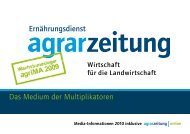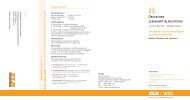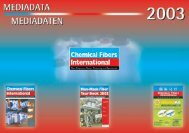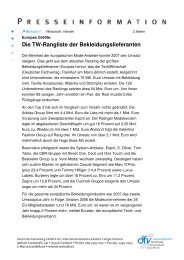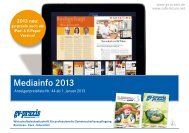P - Deutscher Fachverlag
P - Deutscher Fachverlag
P - Deutscher Fachverlag
Create successful ePaper yourself
Turn your PDF publications into a flip-book with our unique Google optimized e-Paper software.
49<br />
Media-Informationen 2011<br />
1 Titelklappe<br />
2<br />
1. Maxi-Variante<br />
Titelklappe Vorderseite<br />
+ Rückseite, jeweils<br />
außen und innen + U4<br />
18.360,- €<br />
2. Mini-Variante<br />
Titelklappe Vorderseite,<br />
außen und innen<br />
6.325,- €<br />
Frenchcover<br />
Die Titelseite lässt sich<br />
von der Mitte aus nach<br />
links und rechts aufklappen<br />
18.360,- €<br />
3 Gate-cover<br />
Die Anzeigenseiten<br />
werden einmal von<br />
der 2. Umschlagseite<br />
auf geschlagen<br />
18.360,- €<br />
Informationsblatt<br />
Sonderwerbeformen<br />
1. 2.<br />
t: FLWI Ausgabe: 003 / 3<br />
et Deadline: 05-07-2007 12:00<br />
NAME: X001 LETZTE. AEND.: 30Aug2007 13<br />
p2007 BINTZ<br />
Volume 22 D 42804 F<br />
Volume 22 2<br />
usgabe: 003 / 3 Ressort: Aktu<br />
ne: 05-07-2007 12:00<br />
X001 LETZTE. AEND.: 30Aug2007 13:07:56 BED.:a<br />
BINTZ<br />
Volume 22<br />
Food law<br />
Journal for meat production duct d and meat processing<br />
Journal Jour for meat production<br />
Journal for meat production and meat<br />
Hygiene: Safe meat products appling clean room technology<br />
New “Hygiene Package”<br />
of the European Union<br />
07:56 BED.:afrb ZE<br />
and meat processing<br />
logy<br />
”<br />
3/2007<br />
Hygiene strategy<br />
No difference compared<br />
with fresh product<br />
Packaging<br />
Coding solutions for<br />
the meat industry<br />
Slaughtering<br />
Ritual slaughter<br />
of dromedaries<br />
Research & Development<br />
Effect of starter culture<br />
during Nham fermentation<br />
Hygiene: Safe meat products appling clean room technology<br />
Food law<br />
New “Hygiene Package”<br />
of the European Union<br />
D D 42804 42 F<br />
3/2007<br />
Hygiene strategy<br />
No difference compared<br />
with fresh product<br />
Packaging<br />
Coding solutions for<br />
the meat industry<br />
Slaughtering<br />
Ritual slaughter<br />
of dromedaries<br />
Research & Development<br />
Effect of starter culture<br />
during Nham fermentation<br />
t: FLWI Ausgabe: 003 / 3<br />
set Deadline: 05-07-2007 12:00<br />
NAME: X001 LETZTE. AEND.: 30Aug2007 13<br />
p2007 BINTZ<br />
Volume 22 D 42804 F<br />
Editorial<br />
Health safety of foods<br />
requires integrated approach<br />
Dr. Ralf Lautenschläger reflecting on increasing role of hygiene<br />
t the end of June 2007 the 18-month well as chemical resistance guaranties for<br />
A transitional period, which was intend- safe products. Short news about how to<br />
ed to give the Member States of the Eu- check all these properties by analysing oxropean<br />
Union (EU), third countries and ygen, controlling and measuring package<br />
the affected branches of industry the op- volume complete this area.<br />
portunity of preparing for the new food<br />
and feed law requirements, was over. n a way many articles and news in<br />
Coming into force 1 January 2006 the IFLEISCHWIRTSCHAFT International reflect<br />
most fundamental, comprehensive and far- the necessity of thinking in hygienic catereaching<br />
change in the European food and gories. Taking the annual meeting of the<br />
feed law now takes effect equally for all INSCA (International Natural Sausage<br />
feed and food establishments.<br />
Casing Association), the pre-<br />
Due to the motto “from stasentation<br />
of the CMA (China<br />
ble to table” the new law<br />
Meat Association) including<br />
pursues an integrated ap-<br />
the invitation to the World<br />
proach and transfers full re-<br />
Pork Conference in Nanjing<br />
sponsibility to feed and food<br />
2007 or the re-assessment of<br />
companies for the health<br />
BSE related risk of bovine in-<br />
safety of the foods and feeds<br />
testines by the EFSA (Europe-<br />
they produce and bring into<br />
an Food Safety Authority) –<br />
circulation. And the regula-<br />
they all show the raising globtion<br />
is also applying for all<br />
al shipping of meat and meat<br />
meat processors and suppli-<br />
products which requires a high<br />
ers merchandising with the<br />
standard in food safety and<br />
EU Member States. The pre-<br />
hygiene. Some of the scientific<br />
sentation of Irish beef farm-<br />
and research reports published<br />
ers to EU Commission officials, which is with this issue also deal with microbiolog-<br />
reflecting on the lack of effective controls ical aspects of fresh meat and meat prod-<br />
and standards in the Brazilian beef sector, ucts during processing.<br />
is one example of possible consequences<br />
(p. 10).<br />
ther papers highlight technological as<br />
Owell as nutritional properties of differ-<br />
inked and corresponding to this issue’s ent kinds of meat in dependence on proc-<br />
L focus topic on hygiene a detailed deessing and environmental conditions, rescription<br />
of the new EU “Hygiene packspectively. Authors indicated that slaughage”<br />
and its effects on food enterprises is terhouse conditions influence pH and tem-<br />
given. Furthermore, an interesting report perature decline curves of the carcasses<br />
on the implementation of clean room and thus the water holding capacity of<br />
technology in a meat processing and pack- pork. With respect to the nutritional value<br />
aging company is presented. This technol- of pheasants it was shown that there is a<br />
ogy may provide an important prerequi- difference between wild and farm animals.<br />
site to prevent microbiological, chemical Investigating the emulsifying properties of<br />
and physical recontamination and thus to turkey giblets it was concluded that some<br />
produce safe packaged meat products for are suitable to improve the product quali-<br />
the retail market and the consumer. Films ty of cooked wiener type sausages. And fi-<br />
and foils – the second topic focussed in nally, the influence of additives and ingre-<br />
this issue – also regard health safety of dients on the fermentation process – espe-<br />
foods. Only the combination of hygienic cially on the development of Salmonella<br />
processing and application of suitable spp. – of Nham, a Thai fermented meat, is<br />
packaging materials with special properties described.<br />
in terms of flexibility, oxygen barrier attributes,<br />
seal, bond and tensile strength as<br />
Fleischwirtschaft International 3/2007<br />
Journal for meat production odduc<br />
and meat processing<br />
4 Einklapper<br />
Titelseite mit Einklapper,<br />
mit und ohne Perforation<br />
13.060,- €<br />
Profile | Gesprächspartner<br />
Veranstaltungen afz | afz-journal Fleischwirtschaft Fleischwirtschaft International fleischwirtschaft.de + com AGBs<br />
5<br />
6<br />
Banderole<br />
2-seitig bedruckbar<br />
5.970,- €<br />
Post-It<br />
Platzierung ab Seite 5<br />
2.825,- €<br />
7 Lesezeichen + 1/1 Anzeigenseite<br />
Lesezeichen 1-seitig bedruckt,<br />
Platzierung auf einer 1/1<br />
Anzeigenseite, mehrfarbig<br />
2.000,- € (technische Kosten)<br />
+ 5.999,60 € (Kosten für<br />
1/1 Anzeigen seite, mehrfarbig)<br />
Bitte fordern Sie die vollständige Preisliste „Sonderwerbeformen“ an unter (069) 7595-1852<br />
Volume 222<br />
Journal Journ for meat production<br />
3/2007<br />
Hygiene strategy<br />
No difference compared<br />
with fresh product<br />
Packaging<br />
Coding solutions for<br />
the meat industry<br />
Slaughtering<br />
Ritual slaughter<br />
of dromedaries<br />
Research & Development<br />
Effect of starter culture<br />
during Nham fermentation<br />
Hygiene: Safe meat products appling clean room technology<br />
Food law<br />
New “Hygiene Package”<br />
of the European Union<br />
48 | 49<br />
rodukt: FLWI Ausgabe: 003 /<br />
peset Deadline: 05-07-2007 12:00<br />
NAME: X001 LETZTE. AEND.: 30Aug200<br />
7 BINTZ<br />
Volume 22 D 42804 F<br />
Volume 22<br />
Volume 22 D 42804 F<br />
Journal for for meat mea meat t production and an and d meat processing processi processing ng<br />
3/ 3/2007 3 2007<br />
Hygiene strategy<br />
No difference compared<br />
with fresh product<br />
Packaging P Packaging k i<br />
Coding CCoding di solutions l ti for f<br />
the th meat t industry i d t<br />
Slaughtering<br />
Ritual slaughter<br />
of dromedaries<br />
Research & Development<br />
Effect of starter culture<br />
during Nham fermentation<br />
Hygiene: Safe meat products appling clean room technology<br />
Food law<br />
New “Hygiene Package”<br />
of the European Union<br />
p<br />
Journal for meat production and meat processing<br />
Journal for meat product<br />
3 R<br />
07 13:07:56 BED.:afrb ZE<br />
3/2007<br />
Hygiene strategy<br />
No difference compared<br />
with fresh product<br />
Packaging<br />
Coding solutions for<br />
the meat industry<br />
Slaughtering<br />
Ritual slaughter<br />
of dromedaries<br />
Research & Development<br />
Effect of starter culture<br />
during Nham fermentation<br />
Hygiene: Safe meat products appling clean room technology<br />
Food law<br />
New “Hygiene Package”<br />
of the European Union<br />
ction and meat processing<br />
3 007<br />
D 42804 F<br />
Microbiology<br />
Gram-negative bacteria a public health risk<br />
ber of 1.3x10<br />
36 Fleischwirtschaft International 3/2007<br />
5 , 4.1x104 , 6.8x103 ,<br />
and 3.6x103 cfu/g, respectively in<br />
Table 4.<br />
Highest proteolytic activity<br />
was observed in P. putida under<br />
psychrotrophic conditions<br />
whereas P. acidovorans isolates<br />
showed no proteolytic activity<br />
(Tab. 5). Antibiotic susceptibility<br />
results of the isolates obtained<br />
from the raw minced meat are<br />
shown in Table 6.<br />
Discussion<br />
In this study, Pseudomonas performed in Turkey (ELMALI<br />
was the most dominant organism and YAMAN, 2005; TEKINSEN et<br />
followed by Acinetobacter. SAHA al., 1980). In this study, the mean<br />
and CHOPADE (2001) reported count of Enterobacteriaceae was<br />
similar results; 47 (47.96%) out similar to and the total mesophil-<br />
of 98 bacterial strains were Pseuic bacteria count was lower than<br />
domonas and 28 (28.57%) were those of KHALAFALLA and EL-<br />
Acinetobacter in 12 retail meat SHERIF, (1993). According to the<br />
samples. NORTJE et al. (1990) re- Turkish Food Codex 2000/5<br />
ported that Pseudomonas spp. (Anonymous), maximum count<br />
comprised 37.2% of 1,265 psy- of total aerobe mesophilic bactechrotrophic<br />
microbial popularia in fresh minced meat has to be<br />
tions from meat and meat contact 5x10<br />
surfaces, and Acinetobacter and<br />
Alcaligenes were isolated in<br />
4.5% and 2.5%, respectively. In<br />
fresh meat samples, ERIBO and<br />
JAY (1985) found Acinetobacter<br />
in 14.6% (n=20), of which 16<br />
were A. lwoffii and 4 were A. calcoaceticus<br />
isolates. However, in a<br />
study by GENNARI and LOMBAR-<br />
DI (1993), A. lwoffii (71.7%) and<br />
A. anitratum (24.1%) were reported<br />
as the frequent Acinetobacter<br />
species in food strains.<br />
With this investigation, P. fluorescens<br />
(biotype I, II) has been<br />
isolated as predominant species<br />
from Pseudomonas isolates.<br />
These biotypes of meat associated<br />
Pseudomonas fluorescens have<br />
been dealt with only a few studies<br />
(MOLIN and TERNSTROM, 1982).<br />
SHAW and LATTY (1984). P. fluorescens<br />
biotypes I and III were<br />
reported to exist in meat (MOLIN<br />
and TERNSTROM, 1982). SHAW<br />
and LATTY (1984) found P. fluorescens<br />
biotype I in 4% and P.<br />
fluorescens biotype II in 0.9%<br />
amongst 787 strains of Pseudomonas<br />
isolated from meat.<br />
Microbial growth<br />
The results of this work regarding<br />
total mesophilic bacteria<br />
and Enterobacteriaceae were<br />
lower than in the previous studies<br />
6 cfu/g. So, presented results<br />
show that the total aerobe mesophilic<br />
bacteria counts in raw<br />
minced meat are within the acceptable<br />
limits.<br />
Psychrotrophic Enterobacteriaceae<br />
are widely distributed in<br />
meat and meat products, their existence<br />
indicates the possible<br />
presence of harmful bacteria<br />
(LINDBERG et al., 1998; O’BRIEN<br />
and MARSHALL, 1996). Some of<br />
the psychrotrophic Enterobacteriaceae<br />
may constitute a public<br />
health problem if present in large<br />
numbers (LINDBERG et al., 1998).<br />
According to this study, the mean<br />
amount of psychrotrophic Enterobacteriaceae<br />
was 3.6x103 cfu/g.<br />
This result correlates the results<br />
KHALAFALLA and EL-SHERIF’s,<br />
(1993). MOUSA et al., (1993) reported<br />
that the mean values for<br />
total mesophilic and Enterobacteriaceae<br />
were 7.2x108 5 4.3x10 cfu/g., respectively.<br />
UZUNLU and YILDIRIM (2003) reported<br />
that Pseudomonas spp.<br />
cfu/g. and<br />
could be isolated by 4.6x104 In the present study, 48% of<br />
the P.putida isolates had proteo-<br />
Tab. 4: Microbial counts (cfu/g) of the analysed microorganisms in minced lytic activity under psychro-<br />
meat samples (n±=±53; positive samples: 100% each)<br />
trophic conditions. The other<br />
Bacteria Count cfu/g (log10/ml)<br />
Pseudomonas species such as<br />
Min Max Mean<br />
P.fluorescens biotype I and P. flu-<br />
Total aerobe mesophile<br />
microorganisms (30 °C) 2.8x10 orescens biotype II showed proteolytic<br />
activity in 40% and 12%<br />
of the isolates, respectively. P.acidovorans<br />
isolates had no proteolytic<br />
effect (Tab. 5). GRIFFITH<br />
(1989) reported that P. fluorescens<br />
isolates showed proteolytic<br />
activity. In another study; BRAUN<br />
et al. (1999) also reported proteolytic<br />
activity of Pseudomonas<br />
fluorescens in raw and heated<br />
food.<br />
cfu/g<br />
in ground beef. The presence of Antibiotic resistance<br />
these bacteria indicates that gen- Antibiotic use may cause an ineral<br />
hygiene and especially the crease in antibiotic resistance not<br />
high level of aerobe mesophilic only in pathogenic bacterial<br />
count and Pseudomonas count strains but also in strains of endo-<br />
affect the shelf life of ground beef. genous flora of humans and animals.<br />
Multiresistant bacterial<br />
Proteolytic activity<br />
strains of animal origin may<br />
Proteolytic activity is impor- spread into human population eitant<br />
for the development of raw ther by direct contact or through<br />
meat texture and flavour (TOL- foods of animal origin. From re-<br />
DRA, 1998). However, extra-celsistant strains in the human inlular<br />
enzymes, especially protestine, genes coding for resistteases<br />
secreted by psychrotrophic ance to antibiotics can be trans-<br />
bacteria mostly Pseudomonas ferred to bacterial strains belong-<br />
species, are well-known causes of ing to natural microflora (BOspoilage<br />
in meat, milk and dairy GAARD and STOBBERINGH, 2000).<br />
products. Spoilage bacteria such Antibiotic resistance of Pseudo-<br />
as Pseudomonas are generally monas is critical especially when<br />
not harmful, but they will cause hospital infections are concerned,<br />
food to deteriorate or lose quality in which contamination with<br />
by getting mouldy, developing a meat may play a role. In recent<br />
bad odour, or feeling sticky on the years, Acinetobacter has<br />
outside (SIRAGUSA et al., 1998). emerged as an important nosoco-<br />
Pseudomonas in meat can also almial pathogen and it is one of the<br />
low for aerobical spoiling at re- most resistant bacteria to antifrigerator<br />
temperatures (GENNA- biotics and metals (DESHPANDE et<br />
RI et al., 1989; SAHA and CHO- al., 1993; GENNARI and LOMBAR-<br />
PADE, 2001). In addition, Acineto- DI, 1993). According to the prebacter<br />
play an important role in sent results, Pseudomonas, Aci-<br />
the spoilage of meat and foods netobacter and Alcaligenes spe-<br />
under various conditions (FRA- cies were mostly resistant to<br />
ZIER and WESTHOFF, 1995). amoxicillin, ampicillin and second<br />
generation cephalosporins<br />
Only P. acidovorans non-proteolytic<br />
whereas these bacteria were not<br />
Tab. 5: Proteolytic activities of Pseudomonas isolates from raw minced meat resistant to ceftriaxone, a third<br />
samples<br />
generation cephalosporin. This is<br />
Species Number of isolation Proteolysis at +4 °C comparable to the results of GENabs.<br />
% abs. % NARI and LOMBARDI, 1993, except<br />
P. fluorescens biotype I 12 40.0 10 40.0 for ceftriaxon resistance (Tab. 6).<br />
P. fluorescens biotype II 3 10.0 3 12.0<br />
P. putida 14 46.7 12 48.0 Conclusion<br />
P. acidovorans 1 3.3 – –<br />
Total 30 25<br />
Raw minced meat samples<br />
Source: CITAK and KAMANLI Fleischwirtschaft International 3/2007 were contaminated with food<br />
2 (2.45) 5.5x106 (6.74) 1.3x105 (5.11)<br />
Total psychrotrophic<br />
microorganisms (4 °C) 1.2x102 (2.08) 8.5X105 (5.93) 4.1x104 (4.61)<br />
Total Enterobacteriaceae<br />
(30 °C) 1.0x102 (2.00) 6.8x104 (4.83) 6.8x103 (3.83)<br />
Total psychrotrophic<br />
Enterobacteriaceae (4 °C) 2.2x10 (1.34) 3.75x104 (4.57) 3.6x103 Aerobe mesophile counts within acceptable limits<br />
ans isolates<br />
tic activity<br />
sceptibility<br />
s obtained<br />
d meat are<br />
(3.56)<br />
Source: CITAK and KAMANLI Fleischwirtschaft International 3/2007<br />
eudomonass performed rformed in Turkey (ELMALI<br />
t organism and nd YAMAN, 2005; TEKINSEN et<br />
acter. SAHAA all., 1980). In this study, the mean<br />
) reportedd cou ount of Enterobacteriaceae was<br />
7.96%) out similar to and the total mesophil-<br />
were Pseu- ic bacteria bac count was lower than<br />
57%) were thosee t of KHALAFALLA<br />
and ELretail<br />
meat SHERI RIF, (1993). According to the<br />
(1990) re- Tu Turkis ish Food Codex 2000/5<br />
monas spp. (An Anonyymous), maximum count<br />
1,265 psy- of to total aaerobe mesophilic bactealpopularia<br />
in fres esh minced meat has to be<br />
meat contact 5x100<br />
bacter and<br />
solated in<br />
ectively. In<br />
ERIBO and<br />
netobacter<br />
which 16<br />
were A. calowever,<br />
in a<br />
d LOMBAR-<br />
71.7%) and<br />
) were rentAcinetood<br />
strains.<br />
on P fluo-<br />
6 5 4.3x10 cfu/g., respectively.<br />
UZUNLU and YILDIRIM (2003) reported<br />
that Pseudomonas spp.<br />
cfu/g u/g. So, presented results<br />
show w that t the total aerobe mesophilic<br />
bact cteria counts in raw<br />
minced d mea eat are within the acceptable<br />
e limit its.<br />
Psychr hrotrop ophic Enterobacteriaceae<br />
arre wid idely distributed in<br />
meat and meat t pproducts,<br />
their existence<br />
ind ndicates tes the possible<br />
presence of harmful armful bacteria<br />
(LINDBERG et t al., 1998; O’BRIEN<br />
and MARSHALL, , 1996). Some of<br />
the psychrotrophic Enterobacteriaceae<br />
may constitute a public<br />
health problem if present in large<br />
could be isolated by 4.6x104 Total aerobe mesophile<br />
microorganisms g (30 °C) 2.8x10 orescens biotype II sho<br />
teolytic activity in 40%<br />
of the isolates, respective<br />
dovorans isolates had n<br />
lytic effect (Tab. 5).<br />
(1989) reported that P.<br />
cens isolates showed pr<br />
act ctivity. In another study<br />
et al. a (1999) also reporte<br />
lytic tic activity of Pseud<br />
fluor f orescens in raw an<br />
food. d<br />
cfu/g<br />
in ground beef. The presence of An Antibiot otic resistance<br />
these bacteria indicates that gen- Antib A ibiotic use may cau<br />
eral hygiene and especially the crea ease inn antibiotic resis<br />
high level of aerobe mesophilic only y in n pathogenic<br />
count and Pseudomonas count strainns but ut also in strains<br />
affect the shelf life of ground beef. genouus flor ora of humans<br />
mals. Muultiresistant<br />
Proteolytic activity<br />
strains s of aanimal orig<br />
Proteolytic activity is impor- spread into int human hu popu<br />
tant for the development of raw ther by di direct t contact c or<br />
meat texture and flavour (TOL- foods of animaal an origin.<br />
DRA, 1998). However, extra-cel- sistant straains in the hu<br />
lular enzymes, especially pro- testine, genes ge ccoding fo<br />
teases secreted by psychrotrophic ance to antibiootics an can b<br />
bacteria mostly Pseudomonas monas ferred to bacterial bacte strain<br />
species, are well-known ll-known caus causes of ing to natural nat microflo<br />
spoilage in meat, mea milk lk and ddairy<br />
airy GAARD and STOBBERING<br />
products. s. Spoilage bacteria ba such Antibiotic resistance of<br />
as Pseud Pseudomonas are generally monas is critical especia<br />
not harmful, but they will cause hospital infections are co<br />
food to deteriorate or lose quality in which contaminati<br />
by getting mouldy, developing a meat may play a role.<br />
bad odour or feeling sticky on the years Acinetobacte<br />
2 (2.45) 5.5x106 (6.74) 1.3x105 (5.11)<br />
Total psychrotrophic<br />
microorganisms g (4 °C) 1.2x102 (2.08) 8.5X105 (5.93) 4.1x104 (4.61)<br />
Total Enterobacteriaceae<br />
(30 °C) 1.0x102 (2.00) 6.8x10 x104 (4 (4.83) 83) 6.8x103 (3.83)<br />
Total psychrotrophic<br />
Enterobacteriaceae (4 °C) C) 2.2x1 2.2x10 (1.34) 3.75x10 .75x104 (4 (4.57) 5 3.6x103 (3.56 56)<br />
Source: CITAK and KK KAMA AMANLI<br />
Fleischwirtschaft International 3/2007<br />
P



